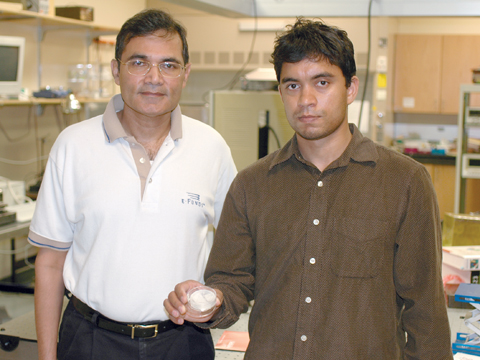| |
|
|

from the issue of July 20, 2006
|

| |
|
|
| |
Sensor could aid medical, robotic fields

Touch Engineered

BY TOM SIMONS, UNIVERSITY COMMUNICATIONS
One of the trickiest decisions facing a cancer surgeon today is where to stop cutting. If the surgeon stops too soon, cancer cells may be left in a patient's body, and if too many cells are taken, organ damage may occur.

| | 
 
| | | DEVICE DEVELOPERS - Ravi Saraf (left) and doctoral student Vivek Maheshwari display a sample of their high-resolution device. The sensor has a touch sensitivity comparable to that of a human finger. College of Engineering courtesy photo.

|
That decision could soon be made easier, thanks to a high-resolution touch sensor developed by UNL chemical engineers that may allow surgeons to tell at the level of a single layer of cells whether or not they have excised a tumor in its entirety.

Ravi Saraf, and his doctoral student, Vivek Maheshwari, reported in the June 9 issue of Science, the international weekly journal of science, that they have developed a self-assembling nanoparticle device that has touch sensitivity comparable to that of the human finger, a capability far beyond any mechanical devices now available.

"The touch resolution of the human finger is 40 microns (40 millionths of a meter)," said Saraf, the Lowell E. and Betty Anderson professor of chemical engineering. "Using nanoparticles, we can attain resolution close to human touch, which is about 50 times better than what is out there today."

Saraf explained that existing technology presents problems for use in minimally invasive surgery because the devices have low resolution, and are expensive and rigid, making them unsuitable for surgical applications.

He said the device that he and Maheshwari developed will be significantly cheaper because the device self-assembles at room temperature. It can also be made to cover an area of 1 square meter or larger, and is flexible enough to cover complex shapes.

The device consists of alternating monolayers layers of gold nanoparticles 10 nanometers (10 billionths of a meter) in diameter and cadmium sulfide nanoparticles 3 nanometers thick, separated by alternating layers of polymers that act as dielectric barriers. The manufacturing process is essentially a series of dip-coatings in various solutions with intermediate washing and drying processes.

"These are conductive and semiconductive materials (gold and cadmium sulfide)," Saraf said. "When you press on the device with an applied voltage across the thickness, that results in larger current and electroluminescent light from the semiconducting particle. By focusing the emitted light intensity from the cadmium sulfide particles or the change in local current throughout the device, you know how much pressure you have applied and how it changes over the contact area."

As a demonstration experiment for the Science paper, Saraf and Maheshwari pressed a penny against a sample device and, using a charged-couple device camera, they were able to decipher fine features such as wrinkles in Abraham Lincoln's clothing.

Saraf said the device also has potential uses in robotics.

"Touch is a sensation they want in robotics because to tell the difference between a cube and a sphere, an ordinary robot takes forever to do it with vision because it has to look from all directions," he said. "With touch, it would 'feel' the sharp edges and say, 'Oh, this is a cube.' And then, of course, the big thing for the military is to maneuver in darkness. Similar to a blind person, (with this device) you can touch and find your way through."

But what interests him most, he said, is the device's potential in the fight against cancer.

"I am excited about this because I want to try to decipher cancer at the single-cell level," Saraf said. "Because in some cases, cancer tissues are harder than normal tissues, if you take a tissue sample, put it on a glass slide and press on it, you would be able to see a cluster of just a few (cancer) cells with this method because it can sense down to about 10 microns (10 millionths of a meter). Surgeons will be able to know if they have taken out all of the cancer. If they haven't, they'll know where to make the next cut."
GO TO: ISSUE OF JULY 20
NEWS HEADLINES FOR JULY 20
Touch Engineered
Child care search widens
Olson calls 50-year university tenure 'a good ride'
Museum program introduces area youth to campus research
NaBRO lands 5-year Korean bridge project
Parking Services update lot, permit designations
Top quark found to be massive
Tsymbal's research noted in 'Science'
732512S35947X
|
|
|
|
|
|
|
|